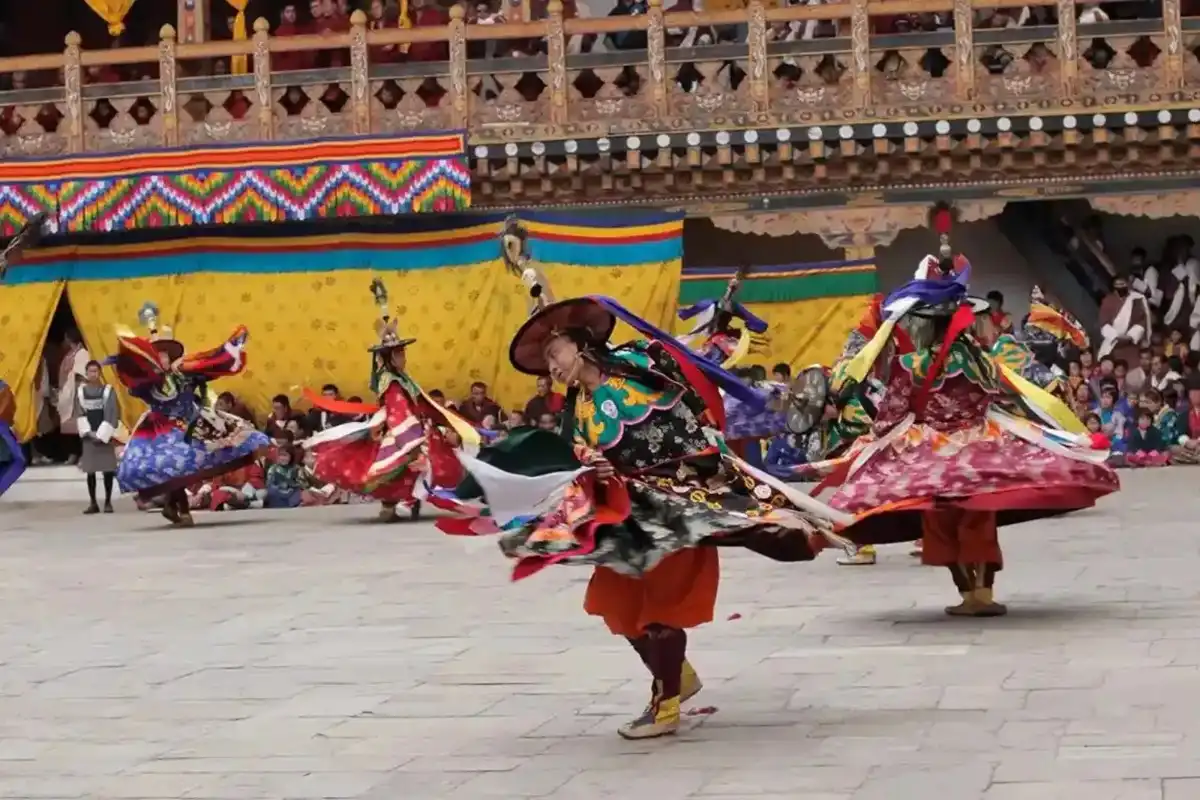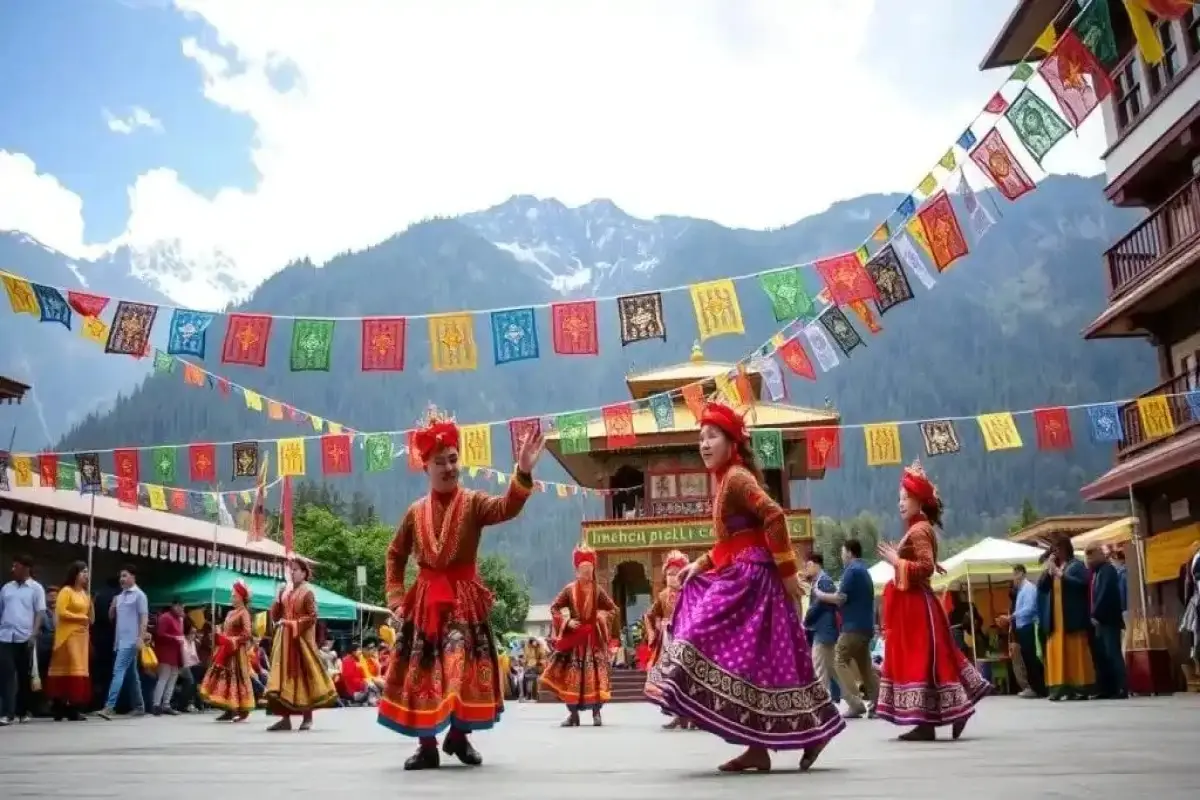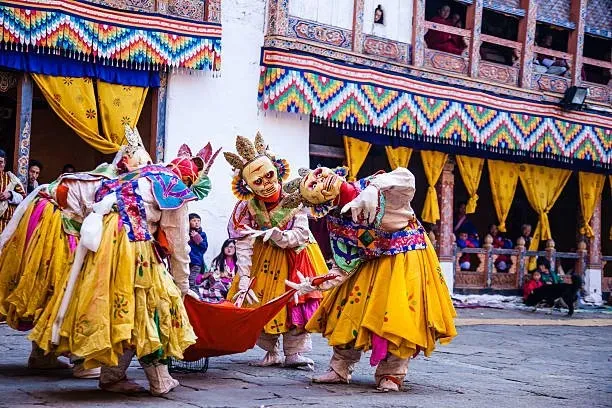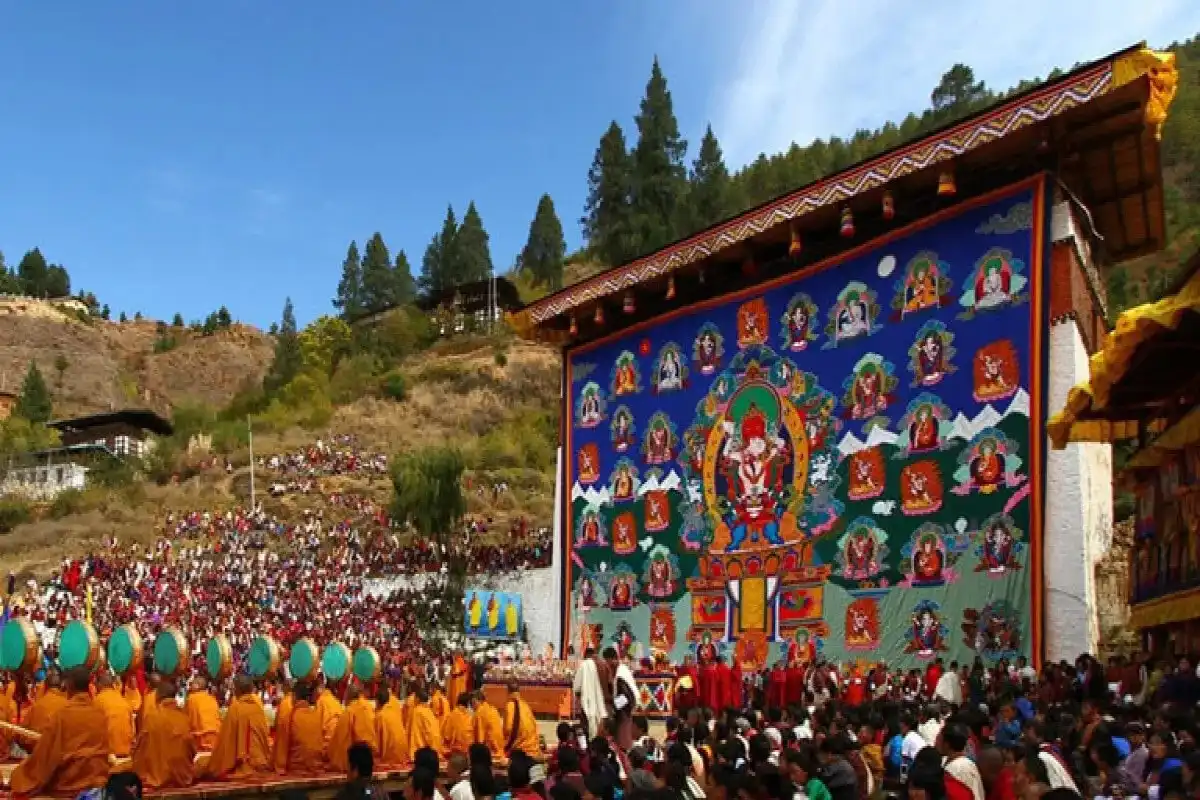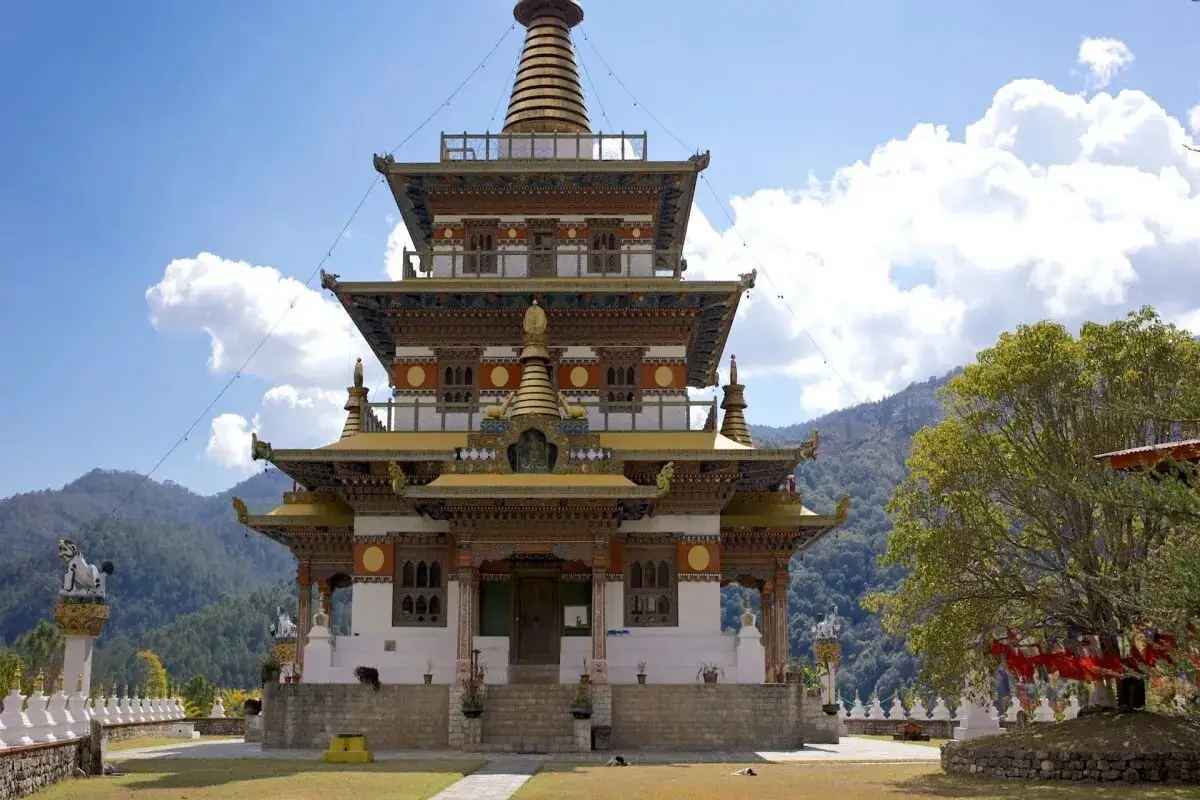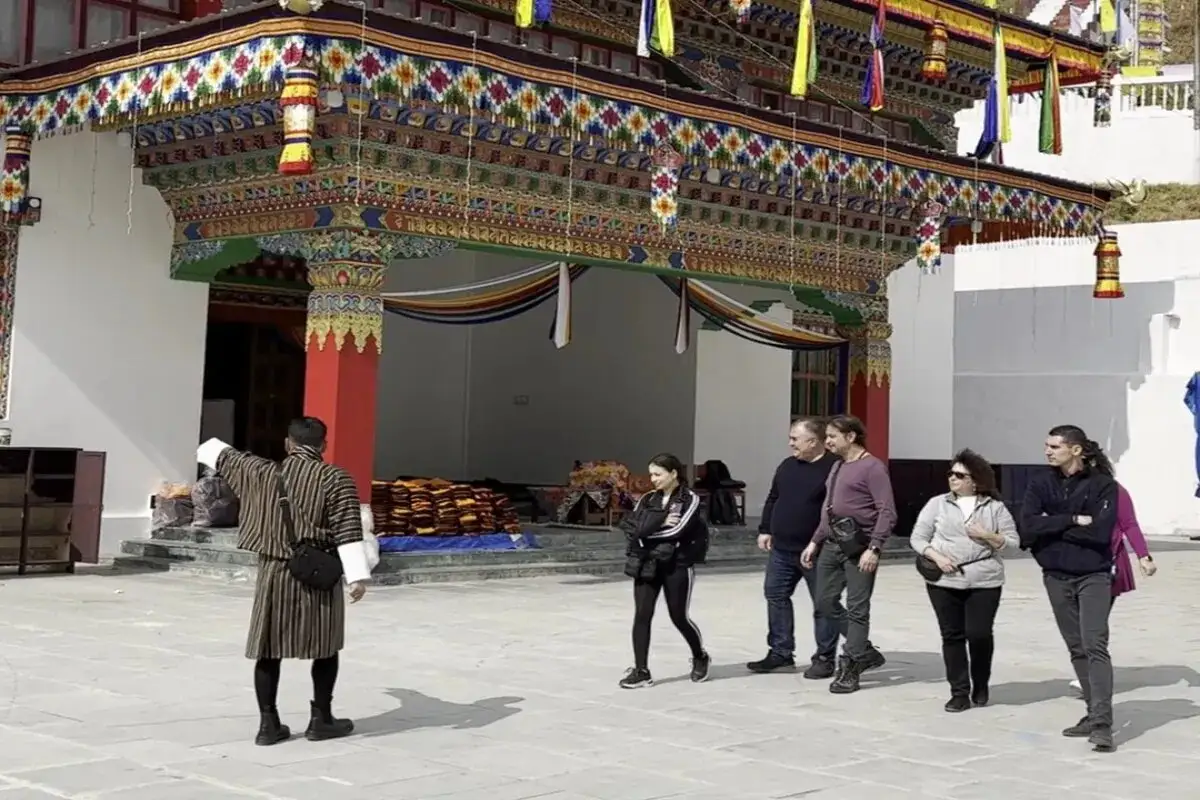Cultural Exploration: Glimpse of Western Bhutan - 7 Days
The 7-day journey uncovers the spiritual and historical treasures of Western Bhutan. It includes wonderful experiences from steep sacred monasteries to breathtaking scenic mountain passes. This trip is ideal for cultural explorers looking for immersion in culture, the beauty of nature, and the undivided unity of the Bhutanese people.
Highlights of the tour
- Tiger’s Nest Monastery (Taktsang Hike)
- Thimphu’s Cultural Corners
- Punakha Dzong’s Architectural Grandeur
- Spiritual Sites & Sacred Temples
Trip Overview
This 7-day journey will take you through the most captivating routes of Bhutan. Here, you’ll get to see nature in its finest form and the untouched beauty of Bhutan. From ancient Dzongs to monasteries and bustling crowds in markets, this trip offers you everything that you are looking forward to. This trip is perfect for nature lovers and travellers who are looking forward to traveling to the least-traveled and beautiful city in the world. People who are seeking for meaningful experience where the itinerary blends perfectly with architecture, nature, and cultural sites must join this trip.
Highlights
Discover Bhutan’s iconic landmarks like the Tiger’s Nest Monastery and Punakha Dzong, along with getting insights into Bhutan. Interact with local people as well as learn about some traditional cultures with them. You'll also be crossing the scenic Dochula Pass with panoramic Himalayan views. Don't miss the experience of seeing the village life, traditional cuisine, and heartfelt local hospitality.
Tiger’s Nest Monastery (Taktsang Hike)
Tiger’s Nest is one of the most famous landmarks of Bhutan. It is situated on a cliff that is 900 meters above sea level. This place holds a lot of religious significance in Bhutan. It is believed that Guru Rinpoche flew there and meditated there for three years. The hike to reach the monastery is rewarding in itself. On the way you’ll see chortens, pine forests, and fluttering prayer flags, which will guide your way through the monastery. After reaching the top, you’re welcomed by the spiritual aura of the monastery. This journey will be more than just a climb,it will be an emotional and spiritual representation of Bhutan’s soul.
Thimphu’s Cultural Corners
Unlike other cities of the world, Bhutan’s capital city, Thimphu, has been preserving its culture for a very long time. Spending a full day in this culturally preserved city brings you closer to the traditions and cultures of Bhutan. Here, you can visit memorial chortens, where you can see prayer wheels spinning, covered in incense that embodies spirituality. You can take a walk along the folk heritage museum, where you can see many cultural souvenirs, talk with the locals, and explore the culture and tradition of Bhutan and the people living there.
Punakha Dzong’s Architectural Grandeur
Punakha Dzong, which is also known as Pungthang Dewa Chenpoi Phodrang, is one of the famous places in Bhutan. It is a fortress that is between the confluence of two rivers, which are the Pho Chhu and Mo Chhu rivers. This Dzong is known as the kingdom of happiness and is also believed to be the second-oldest architecture of Bhutan. It served as the capital city of Bhutan till the mid-20th century and remains a key administrative and monastic center. As you approach the Dzong, you’ll see more of the wooden work, handwoven textiles, and massive whitewashed walls. If you are visiting Bhutan during the spring, you’ll be surrounded by jacaranda trees all covered with purple flowers, which will make your journey more blissful.
Spiritual Sites & Sacred Temples
Aside from the prominent places, the tour also includes quiet ancient regions, which one can consider as temples of tourism. These temples help people to relax and meditate. In Paro, you can visit Kyichu Lhakhang, one of Bhutan’s ancient worship centers and its most prominent temple. It is believed that the temple was built to suppress demons that were obstructing the spread of Buddhism. In Punakha, you can also visit and hike to Khamsum Yulley Namgyal Chorten, a stupa which is situated on the top of a hill. It was constructed to bring achievement and peace to the world. Chimi Lhakhang, the ‘Temple of Fertility’, is also famous and is built to honor and worship the Divine Madman, who is also known as Lama Drukpa Kunley. The temple is unique across the world as a bon of Bhutan with the dynamics of the construction, as the walls and wooden parts of the temple have protective symbols. A visit to any of these temples will help you appreciate the spiritual part of the civilization of Bhutan.
Conclusion
The 7-day cultural exploration of western Bhutan is more than just a trip, this provides you with insights into Bhutan, along with seeing the day-to-day activities of local people. This trip helps you to explore the unique way of life where culture meets simplicity, spirituality, and harmony with nature. Whether you’re hiking to the iconic Tiger’s Nest, eating home-cooked meals, or walking through ancient courtyards, every moment is worth your time. We guarantee you, when you leave Bhutan, you will be leaving with a heavy heart and lots of respect for this place.
This 7-day journey will take you through the most captivating routes of Bhutan. Here, you’ll get to see nature in its finest form and the untouched beauty of Bhutan. From ancient Dzongs to monasteries and bustling crowds in markets, this trip offers you everything that you are looking forward to. This trip is perfect for nature lovers and travellers who are looking forward to traveling to the least-traveled and beautiful city in the world. People who are seeking for meaningful experience where the itinerary blends perfectly with architecture, nature, and cultural sites must join this trip.
Highlights
Discover Bhutan’s iconic landmarks like the Tiger’s Nest Monastery and Punakha Dzong, along with getting insights into Bhutan. Interact with local people as well as learn about some traditional cultures with them. You'll also be crossing the scenic Dochula Pass with panoramic Himalayan views. Don't miss the experience of seeing the village life, traditional cuisine, and heartfelt local hospitality.
Tiger’s Nest Monastery (Taktsang Hike)
Tiger’s Nest is one of the most famous landmarks of Bhutan. It is situated on a cliff that is 900 meters above sea level. This place holds a lot of religious significance in Bhutan. It is believed that Guru Rinpoche flew there and meditated there for three years. The hike to reach the monastery is rewarding in itself. On the way you’ll see chortens, pine forests, and fluttering prayer flags, which will guide your way through the monastery. After reaching the top, you’re welcomed by the spiritual aura of the monastery. This journey will be more than just a climb,it will be an emotional and spiritual representation of Bhutan’s soul.
Thimphu’s Cultural Corners
Unlike other cities of the world, Bhutan’s capital city, Thimphu, has been preserving its culture for a very long time. Spending a full day in this culturally preserved city brings you closer to the traditions and cultures of Bhutan. Here, you can visit memorial chortens, where you can see prayer wheels spinning, covered in incense that embodies spirituality. You can take a walk along the folk heritage museum, where you can see many cultural souvenirs, talk with the locals, and explore the culture and tradition of Bhutan and the people living there.
Punakha Dzong’s Architectural Grandeur
Punakha Dzong, which is also known as Pungthang Dewa Chenpoi Phodrang, is one of the famous places in Bhutan. It is a fortress that is between the confluence of two rivers, which are the Pho Chhu and Mo Chhu rivers. This Dzong is known as the kingdom of happiness and is also believed to be the second-oldest architecture of Bhutan. It served as the capital city of Bhutan till the mid-20th century and remains a key administrative and monastic center. As you approach the Dzong, you’ll see more of the wooden work, handwoven textiles, and massive whitewashed walls. If you are visiting Bhutan during the spring, you’ll be surrounded by jacaranda trees all covered with purple flowers, which will make your journey more blissful.
Spiritual Sites & Sacred Temples
Aside from the prominent places, the tour also includes quiet ancient regions, which one can consider as temples of tourism. These temples help people to relax and meditate. In Paro, you can visit Kyichu Lhakhang, one of Bhutan’s ancient worship centers and its most prominent temple. It is believed that the temple was built to suppress demons that were obstructing the spread of Buddhism. In Punakha, you can also visit and hike to Khamsum Yulley Namgyal Chorten, a stupa which is situated on the top of a hill. It was constructed to bring achievement and peace to the world. Chimi Lhakhang, the ‘Temple of Fertility’, is also famous and is built to honor and worship the Divine Madman, who is also known as Lama Drukpa Kunley. The temple is unique across the world as a bon of Bhutan with the dynamics of the construction, as the walls and wooden parts of the temple have protective symbols. A visit to any of these temples will help you appreciate the spiritual part of the civilization of Bhutan.
Conclusion
The 7-day cultural exploration of western Bhutan is more than just a trip, this provides you with insights into Bhutan, along with seeing the day-to-day activities of local people. This trip helps you to explore the unique way of life where culture meets simplicity, spirituality, and harmony with nature. Whether you’re hiking to the iconic Tiger’s Nest, eating home-cooked meals, or walking through ancient courtyards, every moment is worth your time. We guarantee you, when you leave Bhutan, you will be leaving with a heavy heart and lots of respect for this place.
Short Itinerary
Arrive in Paro, receive traditional welcome, visit Kyichu Lhakhang and explore valley market
Drive to Thimphu, visit Tamchog Lhakhang, explore museums, Buddha Dordenma and local market
Travel to Punakha via Dochula Pass, visit Chimi Lhakhang and Punakha Dzong
Hike to Khamsum Yulley Chorten, join Bhutanese cooking and archery at local farmhouse
Return to Paro, visit Dumtse Lhakhang and engage in traditional farmhouse activities
Hike to Tiger’s Nest Monastery, explore pine forest trail and cliffside temple
Optional visit to National Museum or market shopping, farewell and departure from Paro
Cultural Exploration: Glimpse of Western Bhutan Itinerary
Upon arrival in Paro, you’ll be greeted by your local guide with a traditional scarf called a khadar. Paro is one of the airports with the best views. After this, you’ll drive through the Paro valley. After reaching your hotel, you can check into your room and eat your lunch. After eating your lunch, you’ll visit the Kyichu Lhakhang. Kyichu Lhakhang is one of the sacred temples of Bhutan. It is believed to have been made in the 7th century. After visiting this temple, you can go for an evening walk around the valley, where you can buy Bhutanese souvenirs as well as snacks and handicrafts made by local people there. You’ll stay overnight in the same hotel and leave for another destination the next day.
On this day, you’ll be moving towards Thimpu, which is the capital city of Bhutan. After breakfast, you’ll be going towards Thimphu, which is about a 1.5-hour drive away from Paro. You can stop at the Tamchog Lhakhang. It is a private temple built by a famous bridge builder, Thangthong Gyalpo. After arriving in Thimpu, you can explore the cultural memorial chortens. You can see people praying there as a daily ritual. You can explore cultural sites such as, Folk Heritage Museum for a glimpse into traditional rural life and the School of Traditional Arts (Zorig Chusum) to witness Bhutan’s 13 preserved art forms in practice. Later, you can explore the Buddha Dordenma and the Centenary Farmers Market. You’ll stay today in Thimpu after a full day of sightseeing.
Start your journey to visit Punakha after taking your breakfast. After reaching Dochula Pass(3100 meters), you'll get to see 108 chortens and prayer flags. While on the pass, the eastern Himalayan range can be seen. While moving to the Punakha Valley, you can sip some tea and snack on the way. After reaching and finishing lunch, leave to visit Chimi Lhakhang, the ‘Temple of Fertility’, which blesses couples regardless of which corner of the world they are from. You can go to see the Punakha Dzong, which is the fortress at the confluence of the Pho Chhu and Mo Chhu rivers. The dzong is magnificently decorated with fine carving and blooms in the surrounding jacaranda trees in spring. It is gorgeous and has very beautiful architecture. Conclude the day by resting by the riverside or relaxing at your lodge.
You can start your day by visiting Khamsum Yulley Namgyal Chorten. It is a stunning stupa built by the Queen Mother for peace and harmony. Here, the trails pass through rice fields and farms, offering an awesome view of Punkha Valley. You can enjoy a traditional experience by visiting a nearby village or a traditional Bhutanese farmhouse. You have a conversation with the local people of Bhutan and learn to cook dishes like rice and Ema Datshi with the help of them. Share traditional meals with the local people and learn more about their culture and their day-to-day life experiences. Try Bhutan’s national sport, Archery. Later at night, you can relax with a hot stone bath, which includes ancient healing techniques. Today, you will spend the night in Punakha Valley.
After breakfast, you’ll depart for Paro via Dochula Pass. You can again enjoy the scenic way and the panoramic view on the way. You can have tea and snacks on the way from Punakha to Paro. After you arrive, you can check into your hotel and take some rest. After taking a rest, you can go to visit the traditional Bhutanese Farmhouse. There, you can experience the rural life of the Bhutanese people. Here, you can engage in light activities such as rice pounding, butter churning, or chili drying. Before sunset, take a short walk to the riverside and visit the Dumtse Lhakhang. It is also a rare temple in Bhutan. Later in the evening, you can go to explore the markets of Paro and buy some souvenirs that you want to take back home.
Today you'll go to the famous place of Paro. It is the Tiger's Nest Monastery. After breakfast, you will begin your hike. The way is very peaceful with a pine forest and colourful flags all the way. In between, you'll find a prayer wheel in the water, too. You'll find a viewpoint cafe in the middle, where you can get an exclusive first glance of the beautiful monastery on the cliff. The final climb is steep but very adventure-filled. After exploring and having lunch, you will hike back down. The rest of the day is free; you can explore the valley or take a rest as per your wish. You'll stay overnight in Paro today.
Depending on the time of your flight, you can go for some last-minute shopping in Paro. If you have already completed all your shopping, you can go to see the National Museum of Bhutan, which is located in the historic Ta Dzong. After visiting, you can return to your hotel, now you will be taken to the airport by your guides after having a heart-warming farewell. With the cultural and spiritual insight of Bhutan, you’ll be leaving this place with a heavy heart and lots of respect for the place.
Know Before You Travel
-
Things to do during this trip:
Hike Through Scenic Trails
Bhutan’s trails are very adventurous for people who love to hike and walk through places. On this trip, you’ll have a lot of opportunities to hike. Starting from Tiger’s Nest Monastery, through the pine forest and the steep slope in Paro. Similarly, in Punakha, you’ll get the opportunity to hike to Khamsum Yulley Namgyal Chorten, which offers exclusive panoramic views of the surrounding area full of terraced fields and river banks. Each hike done here mixes adventure and cultural significance perfectly. Whether you are a beginner or a pro hiker, this trip connects you with nature and culture physically as well as spiritually.
Cultural Immersion Activities
This tour offers multiple chances of viewing and seeing Bhutan beyond the lens of tourists. You’ll get to experience Bhutan and its culture more intimately this time. You’ll get to know about their dresses and traditions, and get to wear them too. With the help of your tourist guide, you’ll get to learn the significance of things like Gho and Kira. You will have the opportunity to talk and share experiences with locals there, while getting a hands-on experience of learning the way of making traditional cuisine with them. If your visit coincides with a local tshechu (festival), you may witness traditional mask dances and religious ceremonies that have been practiced for centuries. This experience will make everlasting memories with you.
Visit Museums & Art Schools
Exploration in Bhutan begins with learning and traveling, and its museums and institutes are filled with its rich culture. One of the most popular museums, the Folk Heritage Museum, features cultural exhibits like a distinct living room of a Bhutanese home filled with ancient household items like cooking pots and prayer altars. Bhutanese ‘Zorig Chusum’ modern school teaches thirteen traditional crafts, modern disciplines like thangka painting and metalwork, and embroidery. The nation's efforts to preserve its culture are evident in the education of school children in Bhutan. The National Museum of Bhutan in Paro has a rich collection of Bhutanese dances, arms and armor, masks, and the changing styles of Dzong architecture. Every tourist who comes to Bhutan has always had an appreciation for Bhutanese artistic and spiritual heritage.
Explore Vibrant Local Markets
Markets in Bhutan have more than just shops; they are a cultural centre where locals’ hard work and skills are shown through souvenirs. In Thimphu’s Centenary Farmers’ Market, locals gather to buy and sell many handmade products that local people make. In Paro, you’ll find smaller stalls offering traditional incense, locally-made jewelry, and woolen scarves. Walking through these markets will let you witness the authentic taste of culture and the beauty of Bhutan. These markets are rich in culture and energy. You can purchase a piece of handwoven fabric or getting the experience of the authenticity of Bhutan, the markets give you a unique view of sights and sounds.
FAQs for Cultural Exploration: Glimpse of Western Bhutan
The best time for visiting Western Bhutan is during Spring (March to May) or during Autumn (September to November). These seasons, the weather is nice and mild, offering a clear view of the skies and places.
The Tiger’s Nest Monastery hike is moderately challenging, but people who have basic fitness can easily complete it.
You should expect a homestay kind of accommodation, but all the facilities like warm water, wifi, and other things are provided.
Yes, you’ll have a lot of opportunities to interact with the local people there. You’ll even have the opportunity to share your experience as well as get theirs and learn many Bhutanese traditional things with them.
Pack layered clothing to accommodate varying temperatures. Comfortable walking shoes, a light jacket, sunscreen, a hat, and a reusable water bottle are essential. If you're hiking Tiger’s Nest, a small daypack is recommended.
Yes, travel insurance is required, but we’ll inform you about it as per your comfort level.
Yes, different veg and non-veg dishes will be available as per your food choices and your comfort. We will make sure that you’ll have the best facilities throughout your trip.
You need a visa and all necessary permits for your trip. These documents can not be received on the day of your arrival, so they must be processed before coming here. After you book a trip with us, we will manage these papers for you. Your Bhutan visa is arranged by Orrog as part of the package.
The main way to come to Bhutan is through Paro International Airport, which is well-connected to cities like Bangkok, Delhi, Kathmandu, and Singapore. Most people arrive by air, but if you plan to come via road, you can enter through Phuentsholing, located on the southern border with India, which is the most commonly used entry point.
It is recommended to apply for the visa at least 20 days before your planned departure date so that there is enough time for processing your Bhutan visa, finalizing your itinerary, and arranging your guides and transportation. Although visa processing itself is relatively fast once payment is received, early preparation helps avoid delays and ensures availability, especially during peak seasons (spring and autumn).
You don’t require a passport-size photo for the visa, but it is wise to carry at least 2–4 recent passport-sized photographs during your trip. These may be needed for local permits, registration, or when applying for a local SIM card upon arrival in Bhutan.
Yes, you can lengthen your stay in Bhutan either before or after your trip. Bhutan’s tourism model requires visitors to pay a Sustainable Development Fee (SDF) and a daily package cost, so any extra days will involve additional charges. Extensions are a great opportunity to explore cultural sites in Paro, Thimphu, or even add another short trip or day hike.
Yes, Bhutan requires full tour payment in advance before your visa can be processed and issued. The government of Bhutan regulates this policy to ensure that all travel arrangements are confirmed through a licensed Bhutanese tour operator. We are a licensed tour operator that ensures you have everything you need for a trouble-free trip.
Any personal expenses are not covered in the package like:
- Tips for your guide and other staff
- Bottled drinks and snacks(personal expense)
- Souvenirs or local crafts
Credit cards are easily accepted in major cities like Paro and Thimphu. But in remote areas, you may not have access to a card or an ATM. So, it is best to carry some cash before heading for the trip.
Tipping is not mandatory, but it is a widely appreciated gesture and a customary way to show gratitude for good service. The tipping guideline would be to give USD 5-10 per day as a tip for the guides and other staff.
Paro International Airport is the only international airport in Bhutan. It is well connected by flights from cities like Bangkok, Delhi, Kathmandu, and Singapore.
Yes, airport pick-up and drop-off are included in the package. We will have your guide and driver meet you at the airport and transport you to your hotel.
While Bhutan's roads are mostly paved, some parts are narrow, winding, and occasionally affected by weather. However, we ensure your travel is safe, well-maintained, and driven by an experienced professional throughout the journey.
The Bhutanese Ngultrum is used in Bhutan. All local transactions during the trip will be in BTN.
US Dollars (USD) are generally accepted at larger hotels, souvenir shops, and tour operators, particularly in Paro and Thimphu. However, it’s advisable to convert your currency to BTN for general purchases in rural areas. Other currencies like the Euro or the Pound are not commonly accepted directly.
No, credit or debit cards are not accepted on the trip, as it takes you through remote regions with no banking or electronic payment access. All trip-related payments like accommodation, meals, permits, etc, are paid in advance.
You can exchange foreign currency at the Paro International Airport, at banks, or through licensed money changers in cities like Thimphu and Paro. It's best to exchange enough cash before heading out on the trip.
The national language is Dzongkha, but many Bhutanese also speak English. If you speak English and are worried about communicating with the local people, you will have your guide as a translator.
Yes, all licensed tour guides in Bhutan are required to speak fluent English. Many are also trained in other languages such as German, Japanese, or French. Communication during the trip will be smooth and clear in English.
Most signboards, tourist maps, and information brochures are written in English, especially in tourist destinations like Paro, Thimphu, and trailheads. Directional signs along routes are often labeled in both Dzongkha and English.
No, learning Dzongkha is not at all needed for the trip, but knowing a few basic words like "Kuzu zangpo la" (Hello) or "Kadrinche la" (Thank you) is a good way to interact with the locals.
Language barriers are minimal, as your guide will handle all communication with locals and support staff. Your guide will translate for you during your interaction with the locals.
You can learn about the Bhutanese culture through local interactions, homestay visits, cooking classes, traditional art workshops, and attending local festivals and religious ceremonies
To greet people, you can greet with locals “Kuzu zangpo la” (Hello) by performing a slight bow. Most common greetings include physical greetings, such as shaking hands less visible, especially in rural areas.
Yes, but remember to seek permission, especially when taking photos of monks, locals, or temples. Please note that clicking photos is not allowed at most religious sites.
Visitors should dress modestly and respectfully. This means:
- Covering shoulders and knees
- Removing hats and sunglasses
- Not wearing shorts or sleeveless tops
This applies to both men and women.
Yes, Bhutanese society is deeply rooted in Buddhism and tradition. Here are some key taboos:
- Do not point your feet at people or sacred objects
- Never touch anyone on the head, as it is considered sacred
- Walk clockwise around temples, stupas, and religious monuments
- Avoid public displays of affection
While gifts are not expected, they may be accepted graciously if given with respect. It is advisable to consult with the guide before giving out anything.
Bhutan typically uses Type C, Type D, and Type G electrical outlets. Standard safe voltage is 230V and frequency is 50Hz; therefore, ensure that your equipment is compatible with this voltage.
ndeed, it is highly advised to take along a universal travel adapter, particularly one to fit a variety of types of plugs, because plugs can be different in a hotel or a guesthouse.
Bhutan follows Bhutan Time (BTT), which is UTC/GMT +6 hours. This time zone remains consistent throughout the year.
No, Bhutan does not observe daylight saving time. The country maintains the same time year-round.
Bhutan is 30 minutes ahead of India. For example, 12:00 PM in India is 12:30 PM in Bhutan.
Yes, souvenirs can be bought in Paro or Thimphu before or after the trip.
Some popular souvenirs include hand-woven textiles (kira and gho fabric), prayer flags, thangka (religious scroll) paintings, handmade paper products, traditional masks, and Buddhist artifacts.
You can do some gentle bargaining in local street markets. However, in government-run shops and fixed-price stores, prices are usually non-negotiable.
Only some larger shops in cities like Paro and Thimphu accept credit cards. The remote areas might not have a card payment option, so we suggest that you carry some cash.
Yes, you can easily purchase a SIM card upon arrival in Bhutan. We will assist you with the process, and you'll need a passport copy and a passport-sized photo.
No, internet access is not available during the trip. However, Wi-Fi is available in hotels in Paro and Thimphu before and after the trip.
A: B-Mobile (by Bhutan Telecom) and TashiCell are the two main service providers. B-Mobile tends to have better coverage in rural and mountainous areas
Since the weather can be unpredictable and temperatures can vary drastically, layered clothing is essential. You should pack:
- Base layers (thermal tops and bottoms)
- Insulating layers like fleece or down jackets
- Waterproof and windproof outer layers
- Warm hats, gloves, and neck gaiters for freezing conditions
- Moisture-wicking socks and weatherproof trekking boots
Nighttime temperatures can be extremely cold, especially at high-altitude places. So you need to have enough clothing to keep you warm.
The weather is clear with mild daytime temperatures during spring and autumn.
Reviews & Ratings
-
Guarantee -
Thimphu,Bhutan -
975+17160228
Ready to Explore Bhutan?
Start your journey today and discover the magic of Bhutan with our expert guides and carefully crafted tours.
Book This Trip
-
No booking or credit card fees -
Best price guarantee -
Full customize trip
Ask a Question
Feel free to ask us anything about this tour. A travel expert will then get back to you as soon as possible
Ready to Explore Bhutan?
Start your journey today and discover the magic of Bhutan with our expert guides and carefully crafted tours.

